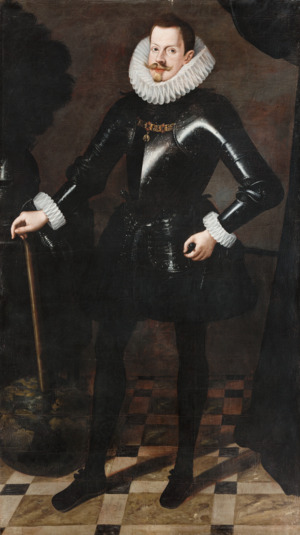Andrés López Polanco facts for kids

Andrés López Polanco (died 1641) was a Spanish painter known for his portraits. He worked during the Baroque period, which was a popular art style in Europe from the early 1600s to the mid-1700s. Polanco was active in Madrid between 1608 and 1641. He painted for the royal courts of King Philip III and King Philip IV of Spain. We don't know his exact birth date.
Contents
About Andrés López Polanco
Andrés López Polanco might have been born in Valladolid, a city in Spain. We can guess this because of his signature on a portrait of Juan Bautista de Acevedo, a bishop of Valladolid. This painting is still kept in the Valladolid cathedral.
Early Career and Life
The first official record of Polanco's work is from 1608. He signed a painting for a monastery in Madrid called Santa Clara. This painting is now in the Arte Museum of Pontevedra.
In 1612, he was asked to help value the belongings of another famous painter, Juan Pantoja de la Cruz, after he passed away. This shows that Polanco was a respected artist.
In 1615, Polanco married Mary Almora. They bought a house in Madrid near an old street called Platería.
Family and Later Life
Polanco's brother, Jerónimo López Polanco, also a painter, died in 1626. Jerónimo stated in his will that he was from Madrid. He asked to be buried in the Church of San Miguel de los Octoes, where their parents, who also lived in Madrid, were buried.
Andrés López Polanco was often involved in valuing art and other items for different businesses. He even helped as an intermediary for the famous artist Alonzo Cano once. Records show that his wife, Mary Almorais, became a widow in November 1641, meaning Polanco died that year.
His Royal Portraits
Polanco painted portraits of King Philip III and Margaret of Austria, Queen of Spain. In these paintings, he followed the usual style for royal portraits of that time. He paid close attention to the details of their clothes.
In 1635, Polanco painted a series of portraits of old Gothic kings for the Buen Retiro Palace in Madrid. One of these paintings was a portrait of the Count-Duke of Olivares. For this painting, Polanco copied a famous portrait by Diego Velázquez. However, Polanco's version was a bit simpler and didn't include the cross of the Order of Calatrava.
See also
 In Spanish: Andrés López Polanco para niños
In Spanish: Andrés López Polanco para niños

